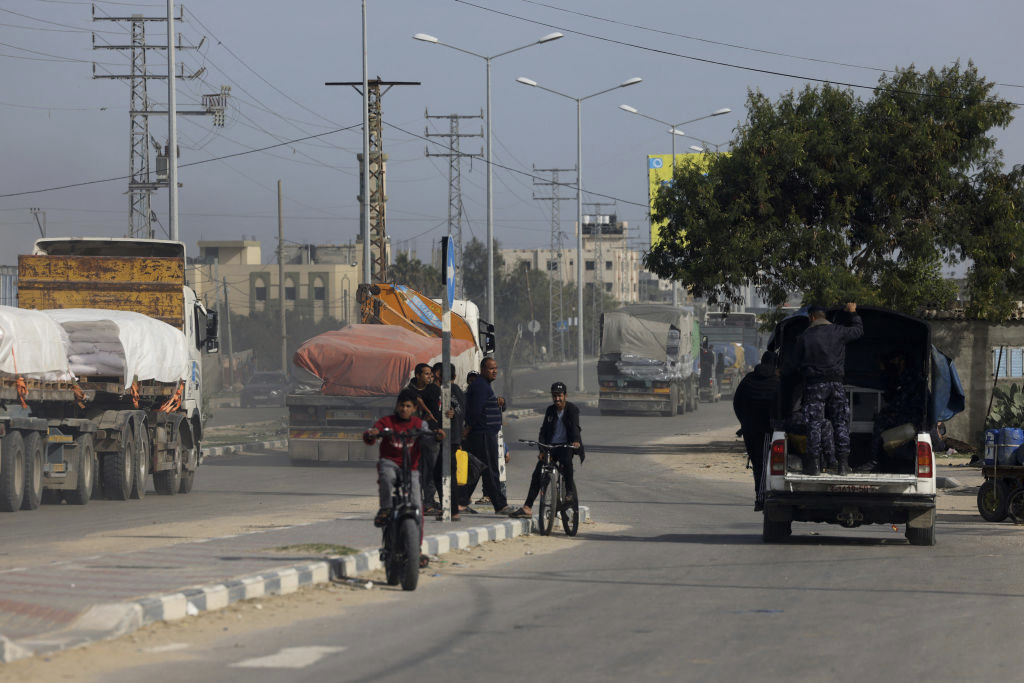The cult of the keffiyeh - How pitying Palestine and hating Israel became the ultimate luxury belief.
Spiked ^ | 20 Dec, 2024 | Brendan O'Neill
Posted on 01/01/2025 6:20:46 AM PST by MtnClimber
This is an extract from Brendan O’Neill’s book, After the Pogrom: 7 October, Israel and the Crisis of Civilisation. You can buy it on Amazon now.
Whatever happened to the sin of cultural appropriation? This ideology of rebuke held sway on university campuses for years. The idea was that no member of the majority group should ever appropriate the cultural habits of a minority group. It’s offensive, apparently. It’s racial theft. It’s parody disguised as authenticity. White men wearing their hair in dreadlocks, white women in kimonos, gay men twerking or using black slang – all of it was damned as ‘stealing’, the co-option of the culture of the powerless by the powerful. And yet today, visit any campus in the West and everywhere you look you’ll see white youths dressed as Arabs.
Keffiyeh chic is all the rage. You’re no one unless you have one of these black-and-white scarves that are widely worn in the Palestinian territories. Student radicals, celebrities, Guardian-reading dads on their way for a macchiato – everyone has a keffiyeh draped over their shoulders. It has become the uniform of the politically enlightened, the must-have of the socially aware. They’re ‘all over Europe’, as one writer says; every time there’s a ‘pro-Palestine’ demo you’ll be confronted by ‘a sea of these garments’. Even the mega-rich are getting in on the act – Balenciaga once made a high-end keffiyeh that will set you back £3,000. But then, you can’t put a price on virtue-signalling.
Is this cultural appropriation? If Beyoncé wearing a sari and Kim Kardashian styling her hair in braids can induce a frenzy of censure among social-justice warriors – as both of those things bizarrely did – then why not bourgeois Westerners pulling on a scarf that has its origins among the nomadic Bedouin tribes of the Arab peninsula? If a student who dons a Mexican sombrero can be branded ‘culturally indifferent’, then why not a student who wraps himself in Arab cloth? As Julie Burchill has wondered, ‘In an age when putting on a sombrero for 60 seconds during a drunken night out at an all-you-can-eat taco bar can be taken as proof of conquistador-level evil… why do these same students swan around wearing the keffiyeh?’.
The keffiyeh wearers will say their scarves are about solidarity, not stealing. They’re showing their support for a political cause, not purloining Palestinian culture. The reason this scarf is ‘worn by non-Palestinians across the world’ is ‘as a sign of solidarity and allyship’, insists Salon. But since when did solidarity involve fancy dress? The 1960s students who protested against the Vietnam War did not wear bamboo conical hats in mimicry of the Vietnamese peasants who so often felt the heat of America’s bombs and napalm. Western supporters of the Quit India movement were not known for wearing white dhotis in the style of Mahatma Gandhi. Solidarity was expressed with words and actions, not imitation of style.
No, there is something else going on with the cult of the keffiyeh, something that falls outside of the traditional realm of solidarity and even awareness-raising. That an item of clothing has become so omnipresent among the virtuous set, that the activist class covets this scarf with such relish that there has been an ‘influx of mass- produced keffiyehs’ into our societies, points to a performative streak in pro-Palestine activism. That it has become de rigueur in certain circles to flout all the laws of ‘cultural appropriation’ and pull on this ‘hot accessory [of] the West’ – as the Guardian calls it – suggests the activist set is as keen to say something about itself and its own rectitude as it is about the predicament of the Palestinian people. That so many progressives rarely leave the house without first wrapping themselves in a keffiyeh confirms the extent to which the Palestine question itself has come to be wrapped up in the personalities of these influencers, in their sense of self, in their very social status.
The cult of the keffiyeh is proof that Palestine has become, in the words of Jake Wallis Simons, the great ‘social signifier’ of the radically chic of the Western world. Pitying Palestine, and by extension hating Israel, has become a ‘core part of a suite of views held by the progressives who set the tenor of much of our culture’, he writes. It has become the ‘luxury belief ’ du jour, the means by which one’s social worth is measured. This goes way beyond ‘cultural appropriation’ – it is the wholesale moral appropriation of an entire people and their plight by the political intimates of high society with virtue to advertise.
Keffiyeh chic has been bubbling and brewing for some time. For Palestinians the scarf has been a symbol of resistance since the 1930s, when Palestinian fedayeen (guerillas) started launching attacks on the British rulers of what was then known as Mandatory Palestine. The fighters donned the keffiyeh in order to erase any ‘markers of identity’ between them, says cultural historian Jane Tynan: whether you were a bourgeois or a peasant who had opted to take up arms against the British, you wore the keffiyeh, making you equals. The keffiyeh exploded into global view in the 1960s with the founding of the Palestine Liberation Organisation by Yasser Arafat and others. Arafat was rarely seen without a keffiyeh draping from his head down his back.
The 1969 photo of Palestinian terrorist Leila Khaled wearing a keffiyeh and holding an AK47 was the thing that really ensured the fame – or infamy – of this item of desert headgear. Khaled was the first woman ever to hijack an airplane, TWA Flight 840 from Rome to Tel Aviv, which she did with her fellow militants in the Popular Front for the Liberation of Palestine. Visions of this 25-year-old wearing a keffiyeh over her hair were beamed around the world, ‘catapult[ing] the keffiyeh into Western consciousness’, says Niloufar Haidari. The first keffiyeh craze started in earnest. Western radicals wore it as evidence of their edginess. There were handwringing debates about ‘terrorist chic’ and the troubling possibility that some youths think ‘terrorism is cool’.

Layla Khaled, one of two hijackers of an American TWA. jetliner in Damascus, smiles after returning to her guerrilla base in Jordan.
In later decades the keffiyeh became a fashion statement of general angst, of a moderate anarchic sentiment, rarely having anything much to do with Palestine. The media’s description of a squatter who was evicted from a pub owned by Gordon Ramsay summed up the sort of people who wore it – he was ‘dressed in a bucket hat, keffiyeh face covering and carrying a skateboard’. Virtually every stall in Camden Market sold them. It had well and truly become a ‘commodity of resistance aesthetics’, in the words of media professor Robert G White. Soon it was on the catwalks. We’ve had ‘peasant glamour’ and ‘hobo style’ – now behold ‘urban combat with a Middle Eastern twist’, wrote fashion critic Charlie Porter in 2001, when the keffiyeh became a must-have again. Belgian fashion designer Raf Simons sent male models down the runway in keffiyehs and ‘skinny black drainpipes and bulky army surplus coats’ – a ‘fiery symbol’, the fashion press gushed.
It featured in the fashion shows of Galliano, Balenciaga and Louis Vuitton. David Beckham, Colin Farrell and Mary-Kate Olsen took to wearing it. Urban Outfitters stocked them (but later withdrew them following complaints). Even Carrie Bradshaw on Sex and the City wore a ‘keffiyeh boob tube’ at one point. From being the headwear of female hijackers to the statement top of Western culture’s best-known single girl – such was the curious journey of this old sartorial staple of the Bedouin.
And now the keffiyeh is back. Since Hamas’s pogrom of 7 October, ‘urban combat with a twist of Middle Eastern’ has become the look once more in socially aware circles. You declare your pronouns, you take the knee and you wear a keffiyeh. And this time, apparently, it’s not fashion, it’s politics. It’s not style, it’s solidarity. It’s no mere ‘fiery symbol’ – it’s a fiery statement of one’s deep convictions about Israel / Palestine. And it certainly isn’t cultural appropriation. As CNN somewhat defensively explained, ‘non-Palestinians should be careful when wearing the keffiyeh in the traditional style worn by Bedouins’, and should always do their ‘research about the garment before wearing it’, but, generally speaking, putting on a keffiyeh can be a ‘great show of solidarity’....SNIP
TOPICS: Society
KEYWORDS: leftism

Click here: to donate by Credit Card
Or here: to donate by PayPal
Or by mail to: Free Republic, LLC - PO Box 9771 - Fresno, CA 93794
Thank you very much and God bless you.
1 posted on 01/01/2025 6:20:46 AM PST by MtnClimber
Disclaimer: Opinions posted on Free Republic are those of the individual posters and do not necessarily represent the opinion of Free Republic or its management. All materials posted herein are protected by copyright law and the exemption for fair use of copyrighted works.
FreeRepublic.com is powered by software copyright 2000-2008 John Robinson

 By Free Republic | Created at 2025-01-01 14:32:06 | Updated at 2025-01-04 08:02:15
2 days ago
By Free Republic | Created at 2025-01-01 14:32:06 | Updated at 2025-01-04 08:02:15
2 days ago







